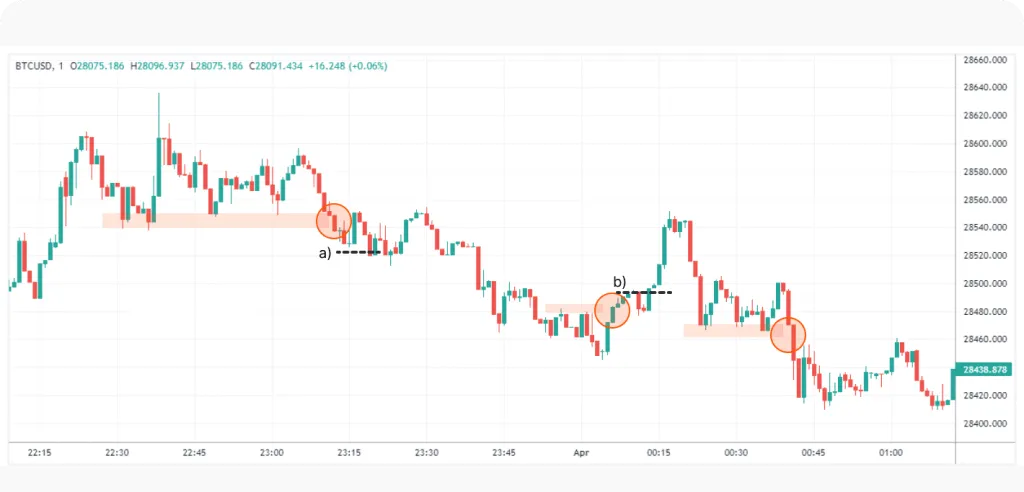The digital currency market is one of the most important and dynamic markets. In this market, technical analysis and how the price moves using candles and their patterns is very important. So, you have to try different trading methods to make profit. One of the most used trading styles is scalping.
Scalping is a trading style that refers to the rapid buying and selling of assets to profit from small price changes in the market. With its unique features, this trading method is very attractive to both beginners and professionals. In this article, we thoroughly examine what scalping is and how it can be used in the digital currency market. So stay with us until the end of the article to learn about its different trading strategies.
What is scalping?
Scalping is a trading style in which traders seek to earn small profits by making multiple trades in a short period of time; Finally, from the sum of these small profits, they get a significant return. Traders who use the scalping method for their transactions are also called scalpers. Scalpers’ target markets are those that have high volume and are heavily influenced by news.
To be able to implement scalping strategies, you must have sufficient market knowledge, technical analysis ability and trading skills such as short-term trading strategy; Because traders use several tools and indicators to identify profitable trading opportunities.
Scalpers use spreads to profit from the difference between supply and demand. A price gap consists of buying at the bid price and selling at the asking price. If traders are willing to accept market prices, profits can be made from this approach even when orders and sales do not change. You just have to be careful not to make mistakes and be able to identify and manage existing risks.
Read more: What is technical analysis and what is its application? + Video
How does scalping work?
Scalping based on three important elements Chart, speed and stability it works For example, scalpers use technical analysis and the difference between the price and the actual value resulting from the bid-ask spread.
Scalpers often trade by buying at the bid price and selling at the ask price. In fact, they choose this method so that they can maintain their position for a short period of time and reduce the risk.
Speed is also important in doing this trading style. One must be able to react quickly to be able to take advantage of short-term fluctuations, even of a few seconds. In this way, the scalper can make a lot of profit from multiple trades with the same technique.
The difference between scalping and swing trading
Both of these styles are short-term trading strategies, but they have key differences in terms of time frame and potential profit.
In the scalping strategy, we seek to make small profits in each transaction by making multiple transactions in a very short period of time, such as a few minutes or even a few seconds. But in a swing trading strategy, we seek to profit from larger price swings by holding positions for a slightly longer period of time, such as a few hours or a few days.
Read more: What is digital currency volatility and how is it done?
The difference between scalping in the digital currency market and the forex market
Scalping trades in the crypto and forex markets are similar in many ways. In both markets, we compare currency pairs and predict the value of one relative to the other. Also, they are similar in terms of infrastructure. Asset prices in both crypto and forex markets are determined by supply and demand.
In addition, trading in crypto and forex markets should be done on a digital platform. Also, many bots automatically open trades for traders. Finally, with a trading robot, you no longer need to control your emotions and everything is done automatically and principled.
But despite the many similarities that these two markets have, there are also important differences between them. For example, in the crypto market, price volatility is much higher than in the forex market. This means that your profit in the crypto market may be more than in Forex. Of course, the same is true for the amount of loss.
In the forex market, you often have to trust brokers, but not in the crypto market. That is, trading in the crypto market can be done with lower and cheaper fees. Also, the digital currency market is active every day of the week and 24 hours a day; But the forex market is only open on working days and hours.
Types of scalping
Scalping can be classified into two categories based on the method you use.
Systemic Scalping
As the name suggests, systematic scalping is done systematically based on predetermined parameters. In this case, the scalper usually determines the ideal time to enter and exit the market with the technical analysis he performs. As a result, decisions will be influenced by technical analysis indicators. In this type of scalping, trading robots are also used to facilitate the execution process.
Discretionary Scalping
Discretionary scalping is the opposite of the systematic type; Because decision-making is mostly spontaneous and based on market conditions. Therefore, in discretionary scalping, instead of relying on indicators, impromptu decisions are made according to market behavior. Of course, this type of scalping may also be subject to a general trading system or framework.
Advantages and disadvantages of scalping
Scalping in the digital currency market has both advantages and disadvantages. The extreme price fluctuations in the crypto market can provide many opportunities for profit, but it also carries a high level of risk.
Scalpers are less exposed to risks such as regulatory changes or major economic events. Also, for some traders, this trading method seems psychologically easier; Because it allows them to earn small profits in a short period of time. In addition, in this style of trading, you do not need to be patient against price fluctuations; But to be successful you must have advanced analytical skills.
On the other hand, this method requires continuous monitoring, which may be time-consuming and tedious. Also, since the profit per trade is very low, scalpers look for highly liquid markets to increase their number of trades. However, according to economists, the large number of trades involved in scalping may not be beneficial. For example, there is no fixed method that can be relied upon to guarantee success 90% of the time; Because one method may be beneficial in one transaction, but not in another transaction. Also, due to the large number of transactions, it may involve exorbitant costs such as fees.
Tools needed for scalping
Different scalp trading tools used by crypto scalpers include leverage, range trading, and bid spreads. We will explain each one below.
- lever: Leverage is a type of loan that traders take from the exchange in exchange for collateral to increase the size of their trading position and earn more profit.
- range trading: Scalp traders who engage in range trading watch for predetermined price ranges to close trades. For example, range trading scalpers use various tools such as support and resistance levels, trend lines, and technical indicators. Also, they use stop orders and limit orders to manage risk.
- bid spread: Using this strategy, scalpers can take advantage of the large price difference between the highest bid and the lowest ask.
- Arbitrage: By buying and selling an asset in different markets, arbitrage scalpers can take advantage of the price difference.
Scalping strategies
Next, we examine 5 scalping strategies.
Range Trading

Range trading is a popular strategy among cryptocurrency scalpers. This strategy involves identifying a specific range of price movements within which an asset fluctuates. The goal of scalpers is to buy at the lower end of the range (support) and sell at the higher end (resistance).
To enter, traders must first check the trading range market in a short time frame such as 1 or 5 minutes. Then, identify the support and resistance levels near the highest and lowest points of the range. These levels will serve as entry and exit points. That is, to take a long position, they enter at the support level and exit the position at the resistance level, and vice versa.
Some people look for reversal candlestick patterns just before entering a market order, such as a hammer candlestick pattern at a support level or a comet at a resistance level. Others place their orders in the form of a limit order at a certain entry point. In other words, they specify their entry price in the market and let their orders be filled at that point.
The loss limit is usually placed beyond the highest or lowest price range, depending on the direction of the trade. Scalpers typically use a 1-to-1 risk-to-reward ratio. Of course, some do not consider the loss limit, which increases the risk too much and is not recommended at all.
Breakout Trading

A breakout occurs when a support or resistance level is broken. This failure indicates the beginning of a trend or its continuation. You can use it in different ways. Of course, be aware that a false breakout has not happened. For this reason, we can use a filter to increase our chances of success.
At the time of entry, we need to identify the level of support or resistance. The easiest way is to look for relatively equal up or down formations, like the chart above. When the level is broken by a strong impulse move, it is better to enter the trade at the end of the broken candle. But when this movement is not strong, like point a and b, then we can wait for a pullback. Traders can place a stop order to enter as a pullback, which is indicated by the dotted line on the chart above.
Profits can be taken at opposing support or resistance levels. However, some scalpers may prefer to ride the trend and track their stop loss above or below swing points as the move progresses. Similarly, the stop loss can be placed above or below the nearest swing points.
Graphic pattern

Chart patterns are a powerful tool for scalping; Because they help traders to identify the continuation of price movement and its reversal.
Charts come in many different patterns, so it’s best to stick to just one or two patterns at least until you’ve mastered them all to avoid confusion. In this example, we use the rising wedge pattern and the falling wedge pattern; Because they often lead to strong price movements.
There are two ways to enter: either on a breakout or retesting a trend line breakout. As you can see in the example, entering the retest method can be more accurate, but you will miss out on some trades. But the failure entry method can be more risky; Because you may not have recognized the failure correctly.
The purpose of determining profit and loss limits depends on the pattern you are using. Given that corner patterns usually trigger a long trend, you can look for support or resistance levels to take profits. Traders who take a more conservative approach can take profits at the extreme point of the pattern. Likewise, the loss limit can be set at the extreme opposite point. For example, you might consider a profit target at the top of an uptrend and a stop loss below the bottom of the pattern.
Using the RSI indicator and Bollinger Bands

Some scalpers use technical analysis indicators such as RSI and Bollinger Bands to determine entries and exits.
- Relative Strength Index (RSI): RSI measures the strength of price movement and can be used to identify overbought or oversold conditions and divergence.
- Bollinger Bands: This indicator helps traders identify periods of high or low volatility and potential price reversals using standard deviations. Scalpers, when the price reaches the upper band of this chart, may think that the price has risen too much at this point and there is a possibility of a price decline. Likewise, when the price reaches the lower band, they may assume that the price has fallen too far and that the price is likely to rise.
When the relative strength index crosses the 70 level, it indicates overbought, and if it falls below the 30 level, this indicates the oversold area. Traders may wait for further confirmation using patterns or more information from the Bollinger Bands indicator; Because they want to decide to enter a trade that is opposite to the current price movement. In this case, if an asset is overbought and crosses the upper band, it can be considered a short position. If the asset is oversold and the price crosses the lower band, a long position can be entered.
As for exit conditions, some scalpers prefer to take profit at the midpoint of Bollinger bands or the opposite band. Others take profits when the RSI breaks above 50 or below, depending on the direction of the trade. In terms of setting a stop loss, the top or bottom near the support or resistance area are good positions. Alternatively, you can choose a specific interval for each trade.
Bid-Ask Spread
The gap or the bid-ask spread is the gap between the maximum price offered by the buyer and the minimum price that the seller can accept for a particular asset. When a spread (difference between the bid and ask price) occurs, traders place buy and sell orders simultaneously. That is, buying is done at the lowest bid price and selling is done at the highest bid price, and the spread is considered as profit.
This strategy can be especially effective in digital currencies that have little liquidity; Because the price spread in these currencies is high and this difference between buying and selling prices can create more opportunities to enter and exit transactions. But it should be noted that with the increase of the spread, the cost of transactions also increases and may decrease the profitability of transactions.
Important points in scalping
- First select a pair of crypto assets for scalping strategy. There are many pairs to choose from, you need to make the right choice based on the liquidity and volatility of the asset. In this case, your work will be easier and you will get more optimal results.
- Find the right platform for scalping. When choosing the right platform, you should check the user interface, the trading experience, the selection of currency pairs and the fees of the services they offer.
- Pay attention to transaction fees. Each platform charges you a fee for making a transaction. Since you, as a scalper, have a large number of trades to do, look for platforms that charge the most competitive trading fees.
- Do not neglect trading robots. In order to succeed in scalping strategy, you have to be fast. Manual portfolio management can be time-consuming and error-prone. Using a program, you can speed up the buying and selling process.
- Try different strategies. You should not have a fixed method. Rather, you should try all the strategies first and finally decide which one will give you the most return.
Frequently asked questions
Scalping trading or scalping is a method in which the trader uses the number of high transactions with low profits based on the difference in the buying and selling prices to make a high profit in total.
A long position is called a buying transaction position; That is, when the trader predicts that the price of a digital currency is increasing and buys it. The shorts position is the opposite of this; That is, the trader predicts that the price of a digital currency is going to decrease and opens a selling position.
A scalper is someone who uses the scalping method to make their trades and make a profit.
summary
Scalping, like any other investment strategy, can be profitable if executed correctly. So to be successful you need to be able to read and interpret charts, understand market performance and try different trading strategies. Consistency and discipline can lead you to success. However, scalping can be difficult; Because it requires high concentration and sufficient knowledge. In addition, you need a lot of capital to achieve high profits with scalping, which may be challenging.
RCO NEWS

















